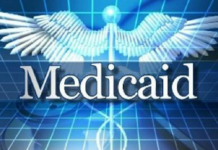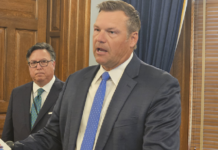It may be the most talked-about press release in Kansas jurisprudence.
Earlier this year when the Kansas Supreme Court threw out the cap on noneconomic damages for personal injury lawsuits, it sent out a press release that the legal community is still trying to understand.
The press release said matter-of-factly that the court’s decision did not cover medical malpractice lawsuits.
But is that really the case and is a press release the best way to understand the court’s opinion?
Lawmakers grappled with that issue this week as they tried to figure out how to respond to the state Supreme Court’s decision eliminating caps on noneconomic damages.

Jeff Chanay, the chief deputy attorney general, pointed to the press release when asked this week about the breadth of the Supreme Court’s ruling on noneconomic damages.
“It would appear — at least if the press release is an accurate representation of what the court believed it was deciding — that it did not change the damage caps in medical malpractice actions,” Chanay told a joint meeting of the House and Senate judiciary committees.
However, Chanay pointed to the dissenting opinion that indicated the decision had far-reaching implications that could affect medical malpractice as well as workers’ compensation and no-fault insurance.
Chanay said it appears that the ruling at the very least applies to caps on noneconomic damages for personal injury lawsuits in the context of motor vehicle crashes and injuries.
“I think the question remains to be answered as to whether or not this would have any greater implication other than that,” Chanay said. “That’s just an unanswered question.”

Republican state Rep. Brad Ralph, a lawyer, acknowledged the unusual nature of relying on a press release to interpret a court opinion.
“We wouldn’t normally refer in our research to press releases if we were arguing before the court in terms of what the parameters of this might be,” Ralph said.
David Morantz, president of the Kansas Trial Lawyers Association, said the press release is baffling.
“That news release is a mystery,” he said. “And citing to it carries no weight, particularly when the Court issued a 60-plus page opinion that details the justices’ holdings.”
The confusion created by the press release was underscored in a white paper commissioned by the Kansas Chamber of Commerce, which called on the governor and the Legislature to respond to the court’s decision.

“The changed policy on noneconomic damages caps has caused tremendous uncertainty in businesses and insurance markets, largely because of widespread misperceptions about the scope of the court’s ruling,” the chamber’s white paper states.
The white paper highlighted the court’s press release, saying it was largely overlooked by many media outlets.
“Numerous media outlets and attorneys overlooked or ignored this clear statement, perhaps because the court did not make this statement public beyond emailing it to journalists and those who specifically requested it.”
The medical and insurance industries are confident that the ruling doesn’t apply to medical malpractice that they asked lawmakers to take a wait-and-see approach to the cap on noneconomic damages.
Kurt Scott, president and chief executive officer for Kansas Medical Mutual Insurance Company, also pointed to the press release when he testified before lawmakers this week.
“This decision is anything but cut and dried and clear, especially we believe as it relates to medical malpractice,” Scott told lawmakers.
“We think there’s reasonable arguments to be made that it does not apply to medical malpractice causes of action,” he said.
Scott said he thought the court’s decision in June didn’t necessarily reverse a 2012 case in which the Supreme Court upheld the state’s cap on noneconomic damages in a medical malpractice case.
In 2012, the court held that the Legislature could impose a cap because plaintiffs received something of value in exchange for modifying the right to a jury trial — in this case the ability to collect liability insurance required of medical providers.
The decision in June that threw out the noneconomic damages cap involved a motor-vehicle crash in which a woman was injured when her car was rear-ended by a semi-truck.
The court “didn’t reverse,” Scott said. “They changed course in this case on this day. They’re very careful about not really saying they reversed anything. They’ve taken a different approach in this case.”
Scott argues that the 2012 case was more on point to medical malpractice than the car-injury case decided in June. He again pointed to the press release from the court.
“They issued a press release that said it didn’t apply to medical malpractice,” he said. “I assume somebody at the court read that before it went out.”
He added, “If we believed strongly (the court) struck down the caps on medical practice cases then I think you’d hear us say we’ve some ideas about what we can do about that.
“I think right now we’re not sure that’s the case.”
Scott urged lawmakers to take a circumspect approach to how it might respond to the court’s opinion.
“We want to make sure that we are thoughtful, that we are deliberate and that we are responsible about what sort of changes we want to make or recommend that you make,” he said.

The Kansas Medical Society took a similar position, urging lawmakers not to hurriedly respond to the court’s decision on noneconomic damages.
“We believe that the court has been probably very intentional and saying this is a personal-injury case,” said Rachelle Colombo, lobbyist for the medical society. “And in the instance of this personal-injury case, we are reversing course.”
Colombo, too, pointed to the court’s press release.
“The question many will ask is what standing does that have in the court,” she said. “We would say we do not yet know.”
Colombo told lawmakers that while the cap may not stand for all personal-injury cases, it’s believed it still applies to medical malpractice. She said there’s not a clear answer for how the Legislature should respond.
“We are going to move forward in that environment,” she said. “Our ask to you would be not to not disrupt that, to allow time for the courts to make it more clear.”
She cautioned that any changes in the law could affect medical malpractice, since it’s part of the overall universe of personal-injury cases.
“If you do something to alter that statute, it could have an impact on our subset,” she said.
The Kansas Chamber of Commerce, however, is still urging the Legislature to take action, although it doesn’t have a specific proposal for restoring the cap structure.
The organization argues the court’s decision will drive up business costs because it creates an uncertain and unpredictable legal climate without the caps in place.
“Make no mistake. This decision will impact everybody,” Eric Stafford, the chamber’s lobbyist, told lawmakers.
“Anybody who is paying car insurance, liability insurance, small businesses that pay insurance, large businesses that have liability coverage — they are all going to pay more because of this decision.”
















